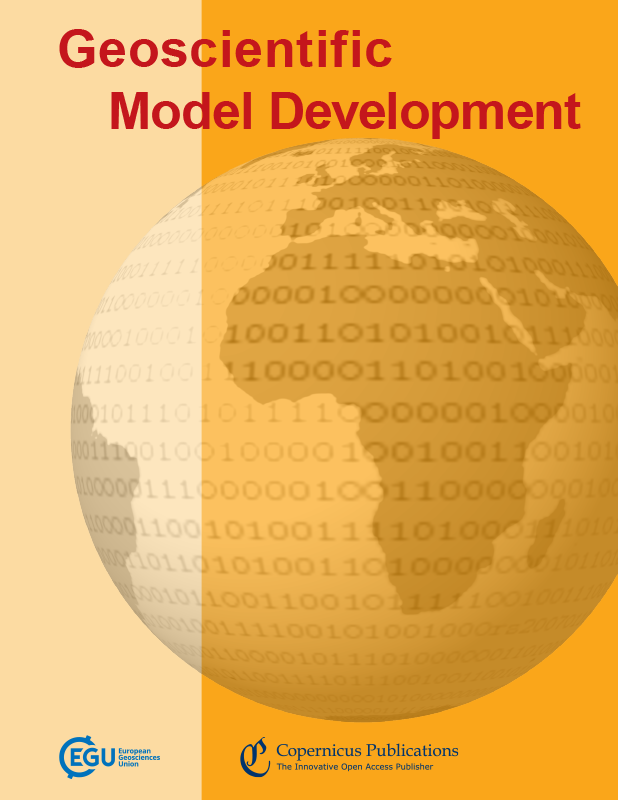The Teddy tool v1.1: temporal disaggregation of daily climate model data for climate impact analysis
IF 4.9
3区 地球科学
Q1 GEOSCIENCES, MULTIDISCIPLINARY
引用次数: 0
Abstract
Abstract. Climate models provide the required input data for global or regional climate impact analysis in temporally aggregated form, often in daily resolution to save space on data servers. Today, many impact models work with daily data; however, sub-daily climate information is becoming increasingly important for more and more models from different sectors, such as the agricultural, water, and energy sectors. Therefore, the open-source Teddy tool (temporal disaggregation of daily climate model data) has been developed to disaggregate (temporally downscale) daily climate data to sub-daily hourly values. Here, we describe and validate the temporal disaggregation, which is based on the choice of daily climate analogues. In this study, we apply the Teddy tool to disaggregate bias-corrected climate model data from the Coupled Model Intercomparison Project Phase 6 (CMIP6). We choose to disaggregate temperature, precipitation, humidity, longwave radiation, shortwave radiation, surface pressure, and wind speed. As a reference, globally available bias-corrected hourly reanalysis WFDE5 (WATCH Forcing Data methodology applied to ERA5) data from 1980–2019 are used to take specific local and seasonal features of the empirical diurnal profiles into account. For a given location and day within the climate model data, the Teddy tool screens the reference data set to find the most similar meteorological day based on rank statistics. The diurnal profile of the reference data is then applied on the climate model. The physical dependency between variables is preserved, since the diurnal profile of all variables is taken from the same, most similar meteorological day of the historical reanalysis dataset. Mass and energy are strictly preserved by the Teddy tool to exactly reproduce the daily values from the climate models. For evaluation, we aggregate the hourly WFDE5 data to daily values and apply the Teddy tool for disaggregation. Thereby, we compare the original hourly data with the data disaggregated by Teddy. We perform a sensitivity analysis of different time window sizes used for finding the most similar meteorological day in the past. In addition, we perform a cross-validation and autocorrelation analysis for 30 globally distributed samples around the world that represent different climate zones. The validation shows that Teddy is able to reproduce historical diurnal courses with high correlations >0.9 for all variables, except for wind speed (>0.75) and precipitation (>0.5). We discuss the limitations of the method regarding the reproduction of precipitation extremes, interday connectivity, and disaggregation of end-of-century projections with strong warming. Depending on the use case, sub-daily data provided by the Teddy tool could make climate impact assessments more robust and reliable.泰迪工具v1.1:用于气候影响分析的每日气候模式数据的时间分解
摘要气候模式以临时汇总的形式为全球或区域气候影响分析提供所需的输入数据,通常采用日分辨率,以节省数据服务器的空间。今天,许多影响模型使用日常数据;然而,亚日气候信息对越来越多的不同部门模式(如农业、水和能源部门)变得越来越重要。因此,开发了开源的Teddy工具(每日气候模式数据的时间分解),将每日气候数据分解(时间降尺度)到次每日小时值。在这里,我们描述并验证了基于每日气候类似物选择的时间分解。在这项研究中,我们应用Teddy工具对来自耦合模式比对项目第6阶段(CMIP6)的偏差校正气候模式数据进行了分类。我们选择分解温度、降水、湿度、长波辐射、短波辐射、地表压力和风速。作为参考,使用1980-2019年全球可用的偏差校正逐时再分析WFDE5(应用于ERA5的WATCH强迫数据方法)数据,考虑了经验日剖面的特定局部和季节性特征。对于气候模式数据中的给定位置和日期,Teddy工具筛选参考数据集,根据等级统计找到最相似的气象日期。然后将参考资料的日廓线应用于气候模式。由于所有变量的日剖面都取自历史再分析数据集中相同的、最相似的气象日,因此保留了变量之间的物理依赖性。泰迪工具严格保留了质量和能量,以精确地再现气候模型的日值。为了进行评估,我们将每小时的WFDE5数据汇总为每日值,并应用Teddy工具进行分解。因此,我们将原始的每小时数据与Teddy分解的数据进行比较。我们对用于寻找过去最相似气象日的不同时间窗大小进行敏感性分析。此外,我们对代表不同气候带的全球分布的30个样本进行了交叉验证和自相关分析。验证表明,Teddy能够再现除风速(>0.75)和降水(>0.5)外所有变量的高相关性>0.9的历史日过程。我们讨论了该方法在再现极端降水、日间连通性和强变暖的世纪末预估分解方面的局限性。根据用例的不同,Teddy工具提供的次日常数据可以使气候影响评估更加稳健和可靠。
本文章由计算机程序翻译,如有差异,请以英文原文为准。
求助全文
约1分钟内获得全文
求助全文
来源期刊

Geoscientific Model Development
GEOSCIENCES, MULTIDISCIPLINARY-
CiteScore
8.60
自引率
9.80%
发文量
352
审稿时长
6-12 weeks
期刊介绍:
Geoscientific Model Development (GMD) is an international scientific journal dedicated to the publication and public discussion of the description, development, and evaluation of numerical models of the Earth system and its components. The following manuscript types can be considered for peer-reviewed publication:
* geoscientific model descriptions, from statistical models to box models to GCMs;
* development and technical papers, describing developments such as new parameterizations or technical aspects of running models such as the reproducibility of results;
* new methods for assessment of models, including work on developing new metrics for assessing model performance and novel ways of comparing model results with observational data;
* papers describing new standard experiments for assessing model performance or novel ways of comparing model results with observational data;
* model experiment descriptions, including experimental details and project protocols;
* full evaluations of previously published models.
 求助内容:
求助内容: 应助结果提醒方式:
应助结果提醒方式:


